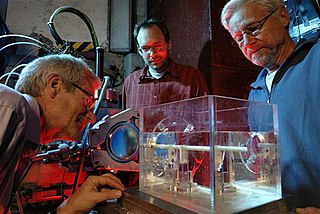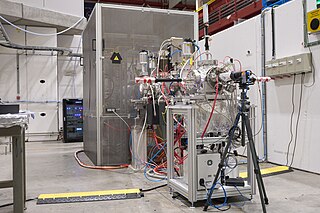
In modern physics, antimatter is defined as matter composed of the antiparticles of the corresponding particles in "ordinary" matter, and can be thought of as matter with reversed charge, parity, and time, known as CPT reversal. Antimatter occurs in natural processes like cosmic ray collisions and some types of radioactive decay, but only a tiny fraction of these have successfully been bound together in experiments to form antiatoms. Minuscule numbers of antiparticles can be generated at particle accelerators; however, total artificial production has been only a few nanograms. No macroscopic amount of antimatter has ever been assembled due to the extreme cost and difficulty of production and handling. Nonetheless, antimatter is an essential component of widely available applications related to beta decay, such as positron emission tomography, radiation therapy, and industrial imaging.

The European Organization for Nuclear Research, known as CERN, is an intergovernmental organization that operates the largest particle physics laboratory in the world. Established in 1954, it is based in Meyrin, western suburb of Geneva, on the France–Switzerland border. It comprises 24 member states. Israel, admitted in 2013, is the only non-European full member. CERN is an official United Nations General Assembly observer.

Antihydrogen is the antimatter counterpart of hydrogen. Whereas the common hydrogen atom is composed of an electron and proton, the antihydrogen atom is made up of a positron and antiproton. Scientists hope that studying antihydrogen may shed light on the question of why there is more matter than antimatter in the observable universe, known as the baryon asymmetry problem. Antihydrogen is produced artificially in particle accelerators.
ATHENA, also known as the AD-1 experiment, was an antimatter research project at the Antiproton Decelerator at CERN, Geneva. In August 2002, it was the first experiment to produce 50,000 low-energy antihydrogen atoms, as reported in Nature. In 2005, ATHENA was disbanded and many of the former members of the research team worked on the subsequent ALPHA experiment and AEgIS experiment.

The Super Proton Synchrotron (SPS) is a particle accelerator of the synchrotron type at CERN. It is housed in a circular tunnel, 6.9 kilometres (4.3 mi) in circumference, straddling the border of France and Switzerland near Geneva, Switzerland.
The Antihydrogen Trap (ATRAP) collaboration at the Antiproton Decelerator facility at CERN, Geneva, was responsible for the AD-2 experiment. It was a continuation of the TRAP collaboration, which started taking data for the TRAP experiment in 1985. The TRAP experiment pioneered cold antiprotons, cold positrons, and first made the ingredients of cold antihydrogen to interact. Later ATRAP members pioneered accurate hydrogen spectroscopy and observed the first hot antihydrogen atoms.

The Proton Synchrotron is a particle accelerator at CERN. It is CERN's first synchrotron, beginning its operation in 1959. For a brief period the PS was the world's highest energy particle accelerator. It has since served as a pre-accelerator for the Intersecting Storage Rings (ISR) and the Super Proton Synchrotron (SPS), and is currently part of the Large Hadron Collider (LHC) accelerator complex. In addition to protons, PS has accelerated alpha particles, oxygen and sulfur nuclei, electrons, positrons, and antiprotons.

The gravitational interaction of antimatter with matter or antimatter has been observed by physicists. As was the consensus among physicists previously, it was experimentally confirmed that gravity attracts both matter and antimatter at the same rate within experimental error.

The Antiproton Decelerator (AD) is a storage ring at the CERN laboratory near Geneva. It was built from the Antiproton Collector (AC) to be a successor to the Low Energy Antiproton Ring (LEAR) and started operation in the year 2000. Antiprotons are created by impinging a proton beam from the Proton Synchrotron on a metal target. The AD decelerates the resultant antiprotons to an energy of 5.3 MeV, which are then ejected to one of several connected experiments.

The Low Energy Anti-Proton Ring (LEAR) was a particle accelerator at CERN which operated from 1982 until 1996. The ring was designed to decelerate and store antiprotons, to study the properties of antimatter and to create atoms of antihydrogen. Antiprotons for the ring were created by the CERN Proton Synchrotron via the Antiproton Collector and the Antiproton Accumulator (AA). The creation of at least nine atoms of antihydrogen were confirmed by the PS210 experiment in 1995.
Atomic Spectroscopy and Collisions Using Slow Antiprotons (ASACUSA), AD-3, is an experiment at the Antiproton Decelerator (AD) at CERN. The experiment was proposed in 1997, started collecting data in 2002 by using the antiprotons beams from the AD, and will continue in future under the AD and ELENA decelerator facility.
High-precision experiments could reveal small previously unseen differences between the behavior of matter and antimatter. This prospect is appealing to physicists because it may show that nature is not Lorentz symmetric.

The Low Energy Ion Ring (LEIR) is a particle accelerator at CERN used to accelerate ions from the LINAC 3 to the Proton Synchrotron (PS) to provide ions for collisions within the Large Hadron Collider (LHC).

The Antiproton Cell Experiment (ACE), AD-4, at the Antiproton Decelerator facility at CERN, Geneva, was started in 2003. It aims to assess fully the effectiveness and suitability of antiprotons for cancer therapy.

The Antihydrogen Laser Physics Apparatus (ALPHA), also known as AD-5, is an experiment at CERN's Antiproton Decelerator, designed to trap antihydrogen in a magnetic trap in order to study its atomic spectra. The ultimate goal of the experiment is to test CPT symmetry through comparing the respective spectra of hydrogen and antihydrogen. Scientists taking part in ALPHA include former members of the ATHENA experiment (AD-1), the first to produce cold antihydrogen in 2002.
AEgIS, AD-6, is an experiment at the Antiproton Decelerator facility at CERN. Its primary goal is to measure directly the effect of Earth's gravitational field on antihydrogen atoms with significant precision. Indirect bounds that assume the validity of, for example, the universality of free fall, the Weak Equivalence Principle or CPT symmetry also in the case of antimatter constrain an anomalous gravitational behavior to a level where only precision measurements can provide answers. Vice versa, antimatter experiments with sufficient precision are essential to validate these fundamental assumptions. AEgIS was originally proposed in 2007. Construction of the main apparatus was completed in 2012. Since 2014, two laser systems with tunable wavelengths and synchronized to the nanosecond for specific atomic excitation have been successfully commissioned.

The Super Proton–Antiproton Synchrotron was a particle accelerator that operated at CERN from 1981 to 1991. To operate as a proton-antiproton collider the Super Proton Synchrotron (SPS) underwent substantial modifications, altering it from a one beam synchrotron to a two-beam collider. The main experiments at the accelerator were UA1 and UA2, where the W and Z bosons were discovered in 1983. Carlo Rubbia and Simon van der Meer received the 1984 Nobel Prize in Physics for their contributions to the SppS-project, which led to the discovery of the W and Z bosons. Other experiments conducted at the SppS were UA4, UA5 and UA8.

The Penning–Malmberg trap, named after Frans Penning and John Malmberg, is an electromagnetic device used to confine large numbers of charged particles of a single sign of charge. Much interest in Penning–Malmberg (PM) traps arises from the fact that if the density of particles is large and the temperature is low, the gas will become a single-component plasma. While confinement of electrically neutral plasmas is generally difficult, single-species plasmas can be confined for long times in PM traps. They are the method of choice to study a variety of plasma phenomena. They are also widely used to confine antiparticles such as positrons and antiprotons for use in studies of the properties of antimatter and interactions of antiparticles with matter.

Jeffrey Scott Hangst is an experimental particle physicist at Aarhus University, Denmark, and founder and spokesperson of the ALPHA collaboration at the Antiproton Decelerator (AD) at CERN, Geneva. He was also one of the founding members and the Physics Coordinator of the ATHENA collaboration at the AD facility.

The PUMA AD-9 experiment, at the Antiproton decelerator (AD) facility at CERN, Geneva, aims to look into the quantum interactions and annihilation processes between the antiprotons and the exotic slow-moving nuclei. PUMA's experimental goals require about one billion trapped antiprotons made by AD and ELENA to be transported to the ISOLDE-nuclear physics facility at CERN, which will supply the exotic nuclei. Antimatter has never been transported out of the AD facility before. Designing and building a trap for this transportation is the most challenging aspect for the PUMA collaboration.













